Autostrada A3 (Italy)
The Autostrada A3 is a motorway in Southern Italy, which runs from Naples to Salerno, in the region Campania.
Until 2017 the route was much longer, going after Salerno further south until Reggio Calabria; on this year, this section became part of the new A2 motorway and of its two spur routes.
 | ||||
|---|---|---|---|---|
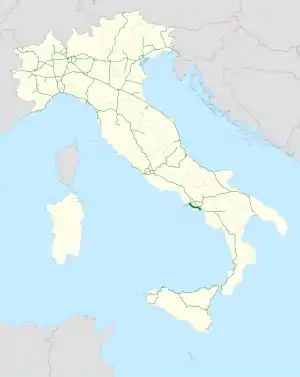 | ||||
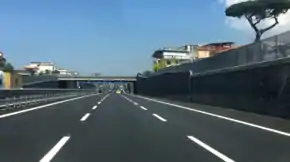 The motorway by Torre Annunziata | ||||
| Route information | ||||
| Maintained by ANAS | ||||
| Existed | 1974 (old route) 2017 (current route)–present | |||
| Major junctions | ||||
| From | Naples | |||
| To | Salerno | |||
| Location | ||||
| Country | Italy | |||
| Regions | Campania | |||
| Highway system | ||||
| ||||
| ||||
Overview
Due to sections not being originally constructed to anywhere near Motorway standard and to the notoriously poor conditions of maintenance, and also to the difficult terrain along some of the route, the motorway has been often taken as a symbol of the backwardness and economical problems of southern Italy. Italian historian Leandra D'Antone has defined it "a true Italian shame".[1] The European Union declines to classify the road as a "motorway" due to the decades-long roadwork restrictions on a supposedly modern road[2] and seeks recompense for its financial contributions.[3]
On 22 December 2016 the Salerno-Reggio Calabria freeway was declared complete, 20 years after the first renovation works started, with the opening of Larìa tunnel in Cosenza.[4] In a ceremony held in Reggio Calabria, prime minister Paolo Gentiloni begged pardon "for the delay"[5] and the road name was changed from "A3 Salerno-to-Reggio Calabria" to "A2 Autostrada del Mediterraneo" (Highway of the Mediterranean).
History
The first stretch of the road to be completed was the Naples-Pompeii section, finished on 22 June 1929. The connection onward to Salerno was completed on 16 July 1961.
In 1964 the Italian government decided to build a motorway which connected the rest of Italy to Calabria, so far considered a kind of "Third Island" (together with Sicily and Sardinia), due to the nature of its terrain, which made it problematic to reach the region. The new motorway was built in a total of 8 years, the works being delivered on 13 June 1974.
The road built by 1974 is more similar to a sub-standard freeway (Italian: strada statale, "state road") than to the other autostrade (motorways) in Italy.[6]
1997–2017 Renovation
Queues became a common feature, especially in summer. To solve the situation, the Italian government funded the construction of a new route which would remove the high gradients and sharp turns and enlarge the carriageway. This required the construction of new tunnels and viaducts (among these the viadotto italia the highest in Italy) while keeping the traffic on the current motorway open. The reconstruction works started in 1997 and officially ended in 2016 during a ceremony although works continued until late 2017. The EU antifraud investigation of works undertaken between 2007 and 2010 together with the repayment of over €300m to the EU in July 2012 have delayed completion of the upgrade works even further.[3][7]
The cost of the upgrade (in August 2013) was projected to reach over €10bn by the time it was eventually completed, then envisaged as 2018. The section from Salerno to Reggio Calabria alone, 442 km long, would cost €10bn with the rest spent on widening/upgrades already completed between Naples and Salerno. €7.443 Bn had been spent up to 2011 on parts of the 442 km section between Salerno and Reggio Calabria.[8][9]
Construction
The entire road was constructed as a substandard freeway[10] by the mid-1970s and later an upgrade program from Naples to Reggio Calabria started in the early 1990s. The section with three lanes in each direction has a length of 105 km, between Naples and RA02 which goes towards Potenza. The section from the interchange with the A1 motorway in Naples to the Pompeii exit, built during the 1920s, originated as a local turnpike, and was later retrofitted to motorway standard. Many of the junctions along the original A3 route completed in the 1970s had very tight corners and extremely limited deceleration fields; this is especially significant on the now more than 50-year-old Naples-Salerno section, where at some junctions there are stop-signs for traffic entering the motorway.[6] Hard shoulders only appeared along the route as part of the post 1990 upgrades, with only occasional emergency bays at infrequent locations on the sections that have not been upgraded yet.
The concession of the Northern part was owned by Autostrade Meridionali, a company listing in Borsa Italiana and a subsidiary of Autostrade per l'Italia, which in turn a subsidiary of Atlantia. The southern segment (Salerno-Reggio Calabria) is toll-free and is maintained by ANAS, the state agency for public routes. Located in a mountainous area, it is prone to very high levels of traffic (especially at the start and at the end of holiday periods).
Upgrade progress
Starting in 1997 the motorway underwent heavy modernisation, in many cases a completely new parallel motorway was built alongside the original A3 and involved in most cases a complete rebuilding or replacement of the road where the alignment was retained.[11]
By August 2014, works on 391 km of the road (88%) were completed. 16 more km of rebuilding/modernization was then due to be completed.[12]
A number of new junctions were also to be constructed, in some cases to service certain towns with no direct access at present.[13]
In May 2015 then prime minister Renzi indicated that the upgrade programme would be terminated by 2016.[14]
By March 2016 68 km remained to be done. Plans to upgrade 58 km were abandoned and changed from Motorway Construction projects to "Maintenance"[15][16]
Sections to be 'maintained' in future are:
Morano Calabro – Firmo, from km 185 + 000 to km 206 + 500: 21 km *Former Macrolotto 3.4
Cosenza – Altilia, from km 259 + 700 to km 286: 26 km *Former Macrolottos 4.1 4.2.1 and 4.2.2
Pizzo Calabro – S.Onofrio, from km 337 + 800 to km 348 + 600: 11 km *Former Macrolotto 5 (originally scheduled for completion 2012)[17]
Maintenance will involve pavement and structural renewal and is projected to cost €1bn between 2016 and 2021 instead of the €3bn that ANAS projected as the cost of fully upgrading the 3 remaining sections.[18]
These total 58 km of the new length of 435 km from Salerno to Campo Calabria and do not include the final 10 km from Campo Calabria to Reggio Calabria which remains as constructed in the 1970s.
also abandoned were a number of planned junctions.[19]
The motorway standard road will terminate at Campo Calabro approximately 10 km to the north of Reggio Calabria, and the remaining 10 km of old A3 into Reggio Calabria will not be upgraded to full motorway standards.
Major Cities
A3 goes through many cities, that are Salerno, Nocera inferiore, Pompei, Torre Annuziata, Torre del Greco, Ercolano, Portici, San Giorgo a Cremano, and Naples.
Route
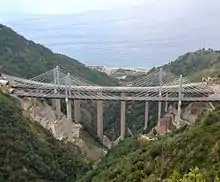
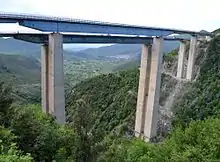
| A2 AUTOSTRADA DEL MEDITERRANEO: NAPOLI – REGGIO CALABRIA | |||||
| Exit | ↓km↓ | ↑km↑ | Province | European Route | |
|---|---|---|---|---|---|
| 2,0 | 51,6 | NA | |||
| 2,5 | 46,1 | NA | |||
| 2,5 | 4,1 | NA | |||
| 5,5 | 45,2 | NA | |||
| 6,4 | 45,2 | NA | |||
| 8,0 | 43,6 | NA | |||
| 8,5 | 43,1 | NA | |||
| 11,5 | 40,1 | NA | |||
| 15,0 | 36,6 | NA | |||
| 20,0 | 31,6 | NA | |||
| 21,9 | 29,7 | NA | |||
| 22,5 | 29,1 | NA | |||
| 25,0 | 26,6 | NA | |||
| 29,7 | 21,9 | SA | |||
| 36,6 | 15,0 | SA | |||
| 42,9 | 8,7 | SA | |||
| 48,4 | 3,2 | SA | |||
| 51,6 | 0,0 | SA | |||
| 0,0 | 442,9 | SA | |||
| 0,2 | 442,7 | SA | |||
| 7,3 | 435,7 | SA | |||
| 13,0 | 429,9 | SA | |||
| 17,5 | 425,4 | SA | |||
| 23,0 | 419,9 | SA | |||
| 30,0 | 412,9 | SA | |||
| 36,1 | 406,8 | SA | |||
| 46,0 | 396,9 | SA | |||
| 54,0 | 388,9 | SA | |||
| 65,0 | 377,9 | SA | |||
| 76,0 | 366,9 | SA | |||
| 83,0 | 359,9 | SA | |||
| 88,0 | 354,9 | SA | |||
| 104,0 | 338,9 | SA | |||
| 124,0 | 318,9 | PZ | |||
| 126,0 | 316,9 | PZ | |||
| 138,0 | 304,9 | PZ | |||
| 145,0 | 297,9 | PZ | |||
| 153,0 | 289,9 | CS | |||
| 164,0 | 278,9 | CS | |||
| 174,0 | 268,9 | CS | |||
| 185,0 | 257,9 | CS | |||
| 194,0 | 248,9 | CS | |||
| 208,0 | 234,9 | CS | |||
| 214,0 | 228,9 | CS | |||
| 220,0 | 222,9 | CS | |||
| 225,0 | 217,9 | CS | |||
| 235,0 | 207,9 | CS | |||
| 246,0 | 196,9 | CS | |||
| 253,0 | 189,9 | CS | |||
| 259,0 | 183,9 | CS | |||
| 273,0 | 169,9 | CS | |||
| 286,0 | 156,9 | CS | |||
| 294,0 | 148,9 | CZ | |||
| 304,0 | 138,9 | CZ | |||
| 320,0 | 122,9 | CZ | |||
| 339,0 | 103,9 | VV | |||
| 348,0 | 94,9 | VV | |||
| 359,0 | 83,9 | VV | |||
| 370,0 | 72,9 | VV | |||
| 383,0 | 59,9 | RC | |||
| 390,0 | 56,9 | RC | |||
| 393,0 | 49,9 | RC | |||
| 401,0 | 41,9 | RC | |||
| 408,0 | 34,9 | RC | |||
| 412,0 | 30,9 | RC | |||
| 423,0 | 19,9 | RC | |||
| 423,0 | RC | ||||
| 433,0 | 10,0 | RC | |||
| 434,0 | 8,9 | RC | |||
| 435,0 | 7,9 | RC | |||
| 436,0 | 6,9 | RC | |||
| 437,0 | 5,9 | RC | |||
| 441,6 | 1,3 | RC | |||
| 442,5 | 0,4 | RC | |||
| 442,9 | 0,0 | RC | |||

See also
References
- (in Italian) ...una vera e propria «vergogna italiana», in La storia della Salerno Reggio Calabria Archived 22 July 2011 at the Wayback Machine, book about Salerno-Reggio Calabria
- Organised crime may be behind problems with southern motorway: Awkward questions remain about Italian infrastructure, in
- Nadeau, Barbie Latza (7 July 2012). "The Mafia-Built Highway That Could Cost Italy $471 Million". The Daily Beast.
- "Salerno-to-Reggio Calabria complete". ANSA. 22 December 2016.
- "Da oggi A2, l'Autostrada del Mediterraneo. Gentiloni: "Scusate per il ritardo"". calabriapage.it (in Italian).
- (in Italian) l'autostrada, completamente statale e senza pedaggio, con le sue due corsie, somiglia più ad una strada statale Salerno-Reggio Calabria: L’autostrada che non c'è Archived 27 February 2011 at the Wayback Machine, La Soria siamo noi, Rai Educational, in which the A3 is defined "the most devastated motorway stretch in Italy".
- Italy Repays €307m to EU after Road Project Mafia Corruption.
- "Anas S.p.A. - Attività dell'Anas sulla Salerno - Reggio Calabria" (in Italian). Archived from the original on 29 September 2011. Retrieved 21 August 2011. Stradaneanas Works Update (in Italian)
- (in Italian)repubblica.it Around €10bn projected for Salerno = Reggio upgrade 6 March 2011 (in Italian)
- Photos and videos of the Salerno-Reggio Calabria "scandal" at A3 Salerno-Reggio Calabria:uno Scandalo! Archived 3 April 2010 at the Wayback Machine, radicalweb.org, 23 January 2010
- (in Italian) Salerno Reggio Calabria ed il General Contractor unico Archived 22 July 2011 at the Wayback Machine, Le strade, May 2007
- (in Italian)ANAS Update Summer 2014 Archived 29 September 2011 at the Wayback Machine
- "Pietro Ciucci ANAS CEO Speech in Brussels 14 November 2012 (English)". Archived from the original on 24 May 2015. Retrieved 10 August 2013.
- "Prime Minister announces completion A3 by 2016, here is the current situation/Premier annuncia completamento A3 entro 2016, ecco la situazione attuale". La Metino. 18 May 2015. Retrieved 30 December 2016.
- "A3 Upgrade History". Stradeanas. Retrieved 19 March 2016.
- "'Maintenance' Plan Infographic March 2016 ( Italian)" (PDF). Stradeanas. Archived from the original (PDF) on 19 March 2016.
- "Autostrada A3: Lotto 5 Pizzo Calabro – Sant'Onofrio" (in Italian). Retrieved 30 December 2016.
- "Sa-Rc, only maintenance for the last 58 km/Sa-Rc, solo manutenzione per gli ultimi 58 chilometri". Il Sole 24. Il Sole 24. 11 March 2016. Retrieved 30 December 2016.
- "Prime Minister announces completion A3 by 2016, here is the current situation". La Metino. 18 May 2015. Retrieved 30 December 2016.
External links
- SAM SpA (in Italian)
- ANAS SpA (in Italian)
- https://web.archive.org/web/20100403054355/http://radicalweb.org/2010/01/a3-salerno-reggio-calabriauno-scandalo-nazionale-il-dossierle-fotoi-video/ Historical perspective and state of the Salerno-Reggio Calabria] (in Italian)
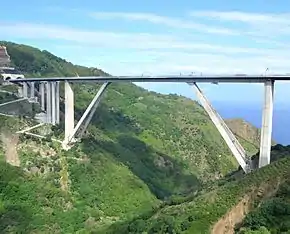
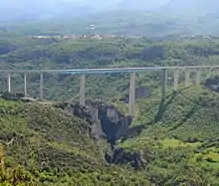
.svg.png.webp)